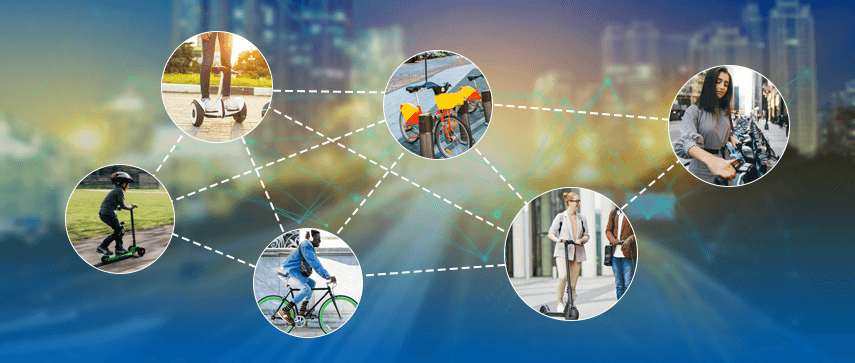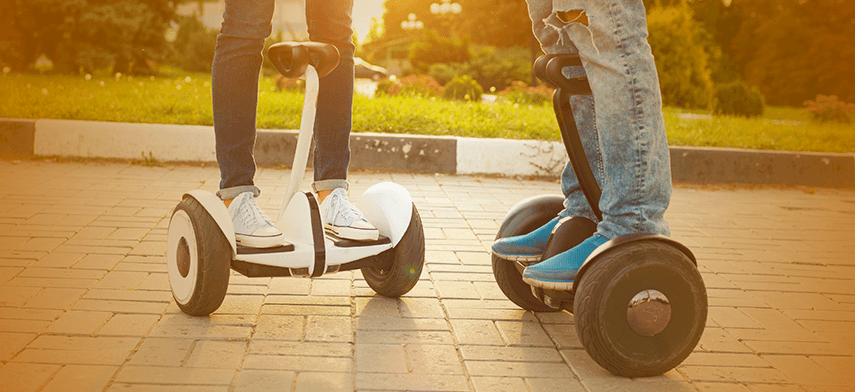You must have seen people traveling on e-bikes and e-scooters in cities like California and New York. If you are wondering about this new trend, it's called micromobility and aims to solve the transportation problems of urban spaces and cities.
Micromobility generally refers to short commutes of less than 5 miles and vehicles that don't go beyond 15 miles/hour. The scooters and bikes use clean energy like rechargeable batteries to fight climate change and provide a sustainable means of transport.
The micromobility market is expected to grow to $300 billion by 2030 in the USA alone. In fact, Micromobility startups have already pumped in $5.7 billion into the industry and looking to capture new cities and urban spaces around the world.
Today, we will explore the trend, its advantages, challenges and the future of micromobility.
The Factors Behind the Growth of Micromobility
Micromobility is gradually becoming popular across the world for its convenience an environment friendliness. Let's go over some factors which have directly contributed to the growth of micromobility.
Last Mile Transport
The last mile transport has always remained a challenge for urban spaces. City planners have long debated what to adopt to provide a cost-effective means of short transportation. Shared Mobility has emerged as one of the cheapest and fastest ways of reaching from point A to point B. In fact, in USA, 60% of all trips are 5 miles or less- providing a great opportunity for the growth of micromobility.
Cheaper Mode of Travel
It takes only a few dollars to ride e-bikes or e-scooters. The charges are much lesser compared to cabs and traditional transportation modes. So cheap rates is also a growth factor for micromobility.
Fast and Easy
Riding a bike or scooter doesn't need any special skills or licenses. You can just unlock a bike with your mobile app and take it for a spin. It's also much faster to navigate the traffic on congested roads in a bike than a car. As a result, you can travel much faster in congested spaces.
Environment-Friendly
One of the most significant factors for the popularity of micromobility is environment friendliness. You are not burning any fossil fuel but relying on clean energy that creates zero pollution. Micromobility becomes the preferred option as more people become conscious about saving the planet.
Smart Cities
Planned cities that focus on energy efficiency and green initiatives have also fueled the growth of micromobility. Smart cities are increasingly adopting greener modes of transport like e-bikes and e-scooters, contributing to the spread of micromobility.
Challenges of Micromobility

Even though micromobility is a growing trend, it has its share of challenges. Some of the challenges are related to the infrastructure of the city, while others deal with regulations and theft. Let's explore some micromobility challenges in brief-
Infrastructure of City
You need proper infrastructure in cities to introduce micromobility. If a city doesn't have requirements like bike lanes or parking spaces, the adoption of micromobility becomes difficult. That's why the adoption of micromobility is low in poor and developing countries. We need proper infrastructure so that people can travel safely without the fear of accidents or injuries. The perception towards micromobility also varies from one country to another. For example, in USA, 70% people living in urban areas view micromobility favorably. That is also the reason behind the widespread adoption of e-bikes and e-scooters across North and South America. On the other hand, countries like Africa have negative perceptions towards cycling. Africans view cycling as past time of the elites or transportation of the poor. For this reason, cycling only makes up 0.2% of all trips in cities like Johannesburg. We need to change the mindset of people to encourage alternative transportation.
Health of Hardware
Micromobility needs a range of hardware for efficient operation. Docking stations, locking gears, tracking technology and more are needed for the seamless operation of e-bikes and scooters. But micromobility companies are increasingly finding it difficult to arrange the required manpower to maintain and take care of the hardware and vehicles. As a result, riders have to go through multiple bikes before they can find one that functions properly. Theft and vandalism also create micromobility challenges. Gobee.bike, a French bike sharing service, had to close its operations after thousands of bikes of the company were stolen or vandalized. There have also been cases of cycle graveyards where people just dump the cycles without parking them in designated spots.
Profitability
Most micromobility companies are finding it difficult to turn up a sustainable profit. Various factors erode the profitability of the micromobility business and leave companies looking for a profitable business model.Amongst the profitability challenges, operation and labor cost hampers the profit of many companies. The micromobility startup Ofo has also closed operations in foreign markets due to inadequate cash flow.Micromobility companies will need to figure out and experiment with new business models to become more sustainable.
Regulation
Micromobility is in its nascent stage and most cities still don't have any regulations around the trend. So it becomes challenging for the administration when they find thousands of e-bikes or e-scooters plying and lined up on the streets on one fine day. Many countries and cities have started developing regulations around micromobility. Shanghai has already put a curb on releasing any more bicycles in the oversaturated city in 2017. China is also developing regulations to ease the micromobility market and punishing people for vandalizing or parking outside designated spaces. North America has its own share of regulations that control the growth or micromobility market. Companies have to get the required permits to operate in cities without which they are fined. Currently, many companies are working with governments around the world to create suitable regulations to make micromobility easy for everyone.
Climate
Too much heat, rain, snow, or cold is not suitable for the adoption of micromobility. People are naturally less inclined to ride an open vehicle in harsh weather conditions in places like northern Europe. As a result, the demand comes down.Rain or snow also makes riding e-bikes and e-scooters dangerous, leading to a high number of accidents. Vehicles also don't last for a long time and have to be replaced. Some companies have started to tackle the issue of weather in innovative ways. For instance, Skip offers winter protection gear to its riders in Washington DC during the winter months.
Advantages of Micromobility
In spite of all challenges, micromobility offers a host of advantages for riders in urban spaces. The benefits outweigh the challenges and make the transportation method a viable option for navigating congested streets and climate change. Here are some advantages of micromobility-
Efficiency
Micromobility is a far more efficient way of traveling short distances. Whether you are riding a bike or an e-scooter, you are always using efficient and clean energy. Just for comparison, a gasoline-powered car can travel a maximum of a mile on one kilowatt hour of energy. On the other hand, one kilowatt-hour of energy is sufficient for an electric scooter to travel 80 miles! That makes it more efficient than even the Tesla Model.So micromobility options provide huge efficiency in terms of energy usage and reduce the dependence on fossil fuels.
Fuel Cost
E-bikes and e-scooters are cost-effective to run and operate. If you compare the fuel costs of an e-scooter with a 28 miles per gallon car, it comes to a little over 1%. So the cost of fuel you save over the course of months and years add up to huge savings. Most companies also charge affordable fees for their micromobility vehicles making it more convenient for the riders.
Production Cost
E-scooters and e-bikes are much cheaper to produce compared to cars and buses. The Tesla Model 3, a super performance electric car comes for around $53,000. When it comes to electric scooters, you can buy 100 high-quality ones for the same price. And e-bikes and cycles even cost lesser!So e-bikes and e-scooters are not only energy-efficient but also have lower costs of production. As a result, they are ideal for an economically and environmentally viable transport option.
Weight
E-bikes and e-scooters reduce the weight of carbon emissions not only while traveling but also during production. An average American vehicle creates around seven tons of CO2 emission during production and weighs 4,100 pounds. Even a short-range electric vehicle creates about eight tons of CO2 emission in the manufacturing line. But e-bikes and e-scooters weigh far less than cars and take much less energy to produce. Micromobility creates far less emission, whether it's on the road or the production line.
Embedded Energies
Micromobility is a powerful option to tackle greenhouse gas emissions and increase access to transportation. E-bikes or e-scooters are cost-effective to produce, run and operate compared to other means of transport. They are also more fuel-efficient and use clean energy without depending on fossil fuels. Energy efficiency is also on top when you adopt micromobility. The benefits are enough to encourage city planners to consider micromobility seriously for fighting climate change and offering affordable transportation.
The Future of Micromobility
By 2050, 68% of the global population will live in cities. Naturally, urban spaces will become more crowded with the need for hassle-free last mile transport. Micromobility can go a long way to reduce the stress on existing transportation networks and offer an affordable and viable means of moving around. Awareness about climate change and the need to protect the earth will also make micromobility a preferred choice in the coming years





 October 14, 2019
October 14, 2019


